MT350CLR
KEM-ML34301-05A
Safety and General Information
I
mportant Information on Safe and Efficient Operation
Read This Information Before Using Your Radio.
The information provided in this document supersedes the general safety
information in user guides published prior to December 1, 2002.
Transmit and Receive Procedure
Your two-way radio contains a transmitter and a receiver. To control your
exposure and ensure compliance with the general population/
uncontrolled environment exposure limits, always adhere to the following
procedure:
• Transmit no more than 50% of the time.
• To receive calls, release the PTT button.
• To transmit (talk), press the Push to Talk (PTT) button.
Transmitting 50% of the time, or less, is important because the radio
generates measurable RF energy exposure only when transmitting (in
terms of measuring standards compliance).
Exposure to Radio Frequency Energy
Your Motorola two-way radio complies with the following RF energy
exposure standards and guidelines:
• United States Federal Communications Commission, Code of Federal
Regulations; 47CFR part 2 sub-part J.
• American National Standards Institute (ANSI)/Institute of Electrical
and Electronic Engineers (IEEE) C95. 1-1992.
• Institute of Electrical and Electronics Engineers (IEEE) C95.
1-1999 Edition.
• International Commission on Non-Ionizing Radiation Protection
(ICNIRP) 1998.
• Health Canada - Safety Code 6; Limits of Human Exposure to
Radiofrequency Electromagnetic Energy in the Frequency Range
from 3 kHz to 300 GHz (2009).
• Australian Communications Authority Radiocommunications
(Electromagnetic Radiation—Human Exposure) Standard, 2003.
• ANATEL ANNEX to Resolution No. 303 of July 2, 2002.
• ANATEL ANNEX to Resolution No. 533 of September 10, 2009.
To ensure optimal radio performance and make sure human exposure to
radio frequency electromagnetic energy is within the guidelines set forth
in the above standards, always adhere to the following procedures.
Portable Radio Operation and EME Exposure
Antenna Care
Use only the supplied or an approved replacement antenna.
Unauthorized antennas, modifications, or attachments could damage the
radio and may violate SUBTEL regulations.
D
o NOT hold the antenna when the radio is “IN USE.” Holding the
a
ntenna affects its effective range.
B
ody-Worn Operation
T
o maintain compliances with SUBTEL RF exposure guidelines if you wear
a
radio on your body when transmitting always place the radio in a
Motorola-supplied or approved clip holder, holster, case or body harness
for this product. Use of non-Motorola-approved accessories may exceed
S
UBTEL RF exposure guidelines.
I
f you do not use one of the Motorola-supplied or approved body-worn
a
ccessories and are not using the radio held in the normal use position,
e
nsure the radio and its antenna are at least 1 inch (2.5 cm) from your
b
ody when transmitting.
D
ata Operation
I
f applicable, when using any data feature of the radio with or without an
a
ccessory cable, position the radio and its antenna at least one inch
(2.5 cm) from the body.
Approved Audio Accessories
• 53724: Remote Speaker with Push-to-Talk Microphone
•
53725: Headset with Swivel Boom Microphone
•
53727: Earbud with Push-to-Talk Microphone
•
53728: Flexible Ear Receiver
•
56320: Earpiece with Boom Microphone
E
lectromagnetic Interference/Compatibility
N
ote: Nearly every electronic device is susceptible to electromagnetic
interference (EMI) if inadequately shielded, designed or otherwise
configured for electromagnetic compatibility. This device complies with
the SUBTEL Resolution Exenta No. 1.261 of 2004 and its modifications.
O
peration is subject to the following two conditions:
1
. This device may not cause harmful interference; and
2. This device must accept any interference received, including
i
nterference that may cause undesired operation.
Facilities
To avoid electromagnetic interference and/or compatibility conflicts, turn
o
ff your radio in any facility where posted notices instruct you to do so.
H
ospitals or health care facilities may be using equipment that is
s
ensitive to external RF energy.
A
ircraft
W
hen instructed to do so, turn off your radio when onboard an aircraft.
Any use of a radio must be in accordance with applicable regulations
per airline crew instructions.
M
edical Devices – Pacemakers
T
he Advanced Medical Technology Association recommends that a
m
inimum separation of 6 inches (15 cm) be maintained between a
handheld wireless radio and a pacemaker. These recommendations are
consistent with the independent research by and recommendations of
the U.S. Food and Drug Administration.
People with pacemakers should:
• ALWAYS keep the radio more than 6 inches (15 cm) from their
pacemaker when the radio is turned ON.
• Not carry the radio in the breast pocket.
• Use the ear opposite the pacemaker to minimize the potential for
interference.
• Turn the radio OFF immediately if there is any reason to suspect that
interference is taking place.
Medical Devices – Hearing Aids
Some digital wireless radios may interfere with some hearing aids. In the
event of such interference, you may want to consult your hearing aid
manufacturer to discuss alternatives.
Medical Devices – Other
If you use any other personal medical device, consult the manufacturer
of your device to determine if it is adequately shielded from RF energy.
Your physician may be able to assist you in obtaining this information.
Safety and General Use While Driving
Check the laws and regulations regarding the use of radios in the area
where you drive, and always obey them. If you do use your radio while
driving, please:
• Give full attention to driving and to the road.
• Use hands-free operation, if available.
• Pull off the road and park before making or answering a call if driving
conditions so require.
The use of a two-way radio while engaged in activities requiring
concentration may cause distraction or otherwise impair your ability to
safely participate in such activities. Always use technology safely.
Do not place a portable radio in the area over an air bag or in the air bag
deployment area. Air bags inflate with great force. If a portable radio is
placed in the air bag deployment area and the air bag inflates, the radio
may be propelled with great force and cause serious injury to occupants
of the vehicle.
Potentially Explosive Atmospheres
Turn off your radio prior to entering any area with a potentially explosive
atmosphere. Only radio types that are especially qualified should be
used in such areas as “Intrinsically Safe.” Do not remove, install or
charge batteries in such areas. Sparks in a potentially explosive
atmosphere can cause an explosion or fire resulting in bodily injury or
even death.
F
or More Information
F
or further information, you may contact Motorola Solutions, Inc. as follows:
C
hile: Call 0-800-201-442
N
ote: The areas with potentially explosive atmospheres referred to above
i
nclude fueling areas such as below decks on boats, fuel or chemical
t
ransfer or storage facilities, areas where the air contains chemicals or
particles (such as grain, dust or metal powders) and any other area
where you would normally be advised to turn off your vehicle engine.
A
reas with potentially explosive atmospheres are often—but not
a
lways—posted.
B
lasting Caps and Areas
T
o avoid possible interference with blasting operations, turn off your
r
adio when you are near electrical blasting caps, in a blasting area, or in
areas posted “Turn off two-way radios.” Obey all signs and instructions.
Operational Cautions
A
ntennas
Do not use any portable radio that has a damaged antenna. If a
damaged antenna comes into contact with your skin, a minor burn can
result.
Batteries
All batteries can cause property damage and/or bodily injury such as burns
i
f a conductive material—like jewelry, keys or beaded chains— touch
e
xposed terminals. The conductive material may complete an electrical
c
ircuit (short circuit) and become quite hot. Exercise care in handling any
c
harged battery, particularly when placing it inside a pocket, purse or other
c
ontainer with metal objects.
E
xercise care when removing NiMH or AA batteries. Do not use sharp or
c
onductive tools to remove either of these batteries.
Battery Charger Safety Instructions:
Save these Instructions
1. Do not expose the charger to rain or snow.
2. Do not operate or disassemble the charger if it has received a sharp
blow, or has been dropped or damaged in any way.
3. Never alter the AC cord or plug provided with the unit. If the plug will
not fit the outlet, have the proper outlet installed by a qualified
electrician. An improper condition can result in a risk of electric
shock.
4. To reduce the risk of damage to the cord or plug, pull the plug rather
than the cord when disconnecting the charger from the AC
receptacle.
5. To reduce the risk of electric shock, unplug the charger from the
outlet before attempting any maintenance or cleaning.
6
. Use of an attachment not recommended or sold by Motorola may
r
esult in a risk of fire, electric shock or personal injury.
7. Make sure the cord is located so it will not be stepped on, tripped
over or subjected to damage or stress.
8. An extension cord should not be used unless absolutely necessary.
Use of an improper extension cord could result in a risk of a fire
and/or electric shock. If an extension cord must be used, make sure
that:
• The pins on the plug of the extension cord are the same number,
size and shape as those on the plug of the charger.
• The extension cord is properly wired and in good condition.
• The extension cord size is 18 AWG for lengths up to 100 feet, and
16 AWG for lengths up to 150 feet.
9. The supply cord of the AC adaptor cannot be replaced. If the cord is
damaged, call customer service at 0-800-201-442 Chile.
Licensing Information
Your Motorola radio has 33 operating channels and conforms to
Subsecretaría de Telecomunicaciones (SUBTEL) Resolution 1.261.
SUBTEL requires all users of these radios to have a Banda Local permit.
Chile - MT350CLR
Servicio de Banda Local UHF frequency use is subject to SUBTEL
Resolution 1.261 and Resolution 52 Exenta. A license is required for use
in Chile. To obtain a Banda Local end-user license:
1. Fill out the required application form to request Local Band service.
a. It is available on the SUBTEL website: http://www.subtel.gob.cl/
index.php?option=com_content&view=article&id=1388&Itemid=2087
b. It is also available at the SUBTEL offices:
Subsecretaría de Telecomunicaciones
Unidad de Licencias y Permisos
Lorenzo Gotuzzo N°124, piso 6
Santiago, Chile
Tel. (56-2) 421 3634
2. Present this form with your ID at the above location.
3. Consult the SUBTEL offices for applicable fees.
For more information, consult SUBTEL at www.subtel.cl or call their
offices at the telephone number listed above.
®
I
nstalling the Batteries
E
ach radio can use either 1 NiMH rechargeable battery pack or 3 AA
a
lkaline batteries and beeps when the batteries are low.
I
nstalling NiMH Rechargeable Battery Pack
1
. Turn the radio off.
2
. With the back of the radio facing you, loosen the retaining screw on
t
he battery door and open the cover.
3
. Remove the NiMH battery pack from the clear plastic bag (do not
d
isassemble or unwrap the battery pack).
4
. Insert the NiMH battery pack with the diagram facing you. (The
r
ibbon should be underneath the battery pack and should wrap
a
round the right side of the pack for easy removal.)
5
. Close the battery cover and tighten the retaining screw on the
b
attery door.
I
nstalling the Three AA Alkaline Batteries (Optional Accessory)
1
. Turn the radio off.
2
. With the back of the radio facing you, loosen the retaining screw on
t
he battery door and open the cover.
3
. Insert the three AA alkaline batteries with + and - polarity as shown
i
nside. (The ribbon should be underneath the AA alkaline batteries
a
nd should wrap around the right side of the batteries.)
4
. Close the battery cover and tighten the retaining screw on the
b
attery door.
Radio Battery Meter
T
he radio battery icon shows the battery charge level, from full to
e
mpty . When the radio has one segment left, the
radio chirps periodically or after releasing (Low Battery Alert).
R
emoving the NiMH Battery Pack
1
. Turn the radio off.
2
. With the back of the radio facing you, loosen the retaining screw on
t
he battery door and open the cover.
3. Remove the NiMH battery pack by pulling the ribbon attached to
t
he radio.
4. Close the battery cover and tighten the retaining screw on the
b
attery door.
R
emoving the Three AA Alkaline Batteries (Optional Accessory)
1
. Turn the radio off.
2. With the back of the radio facing you, loosen the retaining screw on
the battery door and open the cover.
3
. Gently remove each alkaline battery by easing each battery out
i
ndividually.
4. Close the battery cover and tighten the retaining screw on the
battery door.
Notes
• Exercise care when removing NiMH or AA batteries. Do not use
sharp or conductive tools to remove either of these batteries.
• Remove the batteries before storing your radio for extended periods
of time. Batteries corrode over time and may cause permanent
damage to your radio.
Using the mini-USB Charging Adaptor
The mini-USB charging adaptor allows you to conveniently charge your
NiMH battery pack. This is an alternative to charging your NiMH battery
pack in the Battery Charger desk stand using the AC wall adaptor and
especially useful when used while traveling.
Available mini-USB charging options:
1. Vehicle charger
2. Mini-USB computer cable
If using a computer, the computer must be turned on.
This and other accessories (sold separately) are available for your radio.
For more information, visit our Web site at
motorolasolutions.com/talkabout or shop.giantintl.com.
1. Plug your mini-USB cable or charger into a power source as is
appropriate for your accessory.
2. Plug the cable into the mini-USB port on the bottom of your radio.
3. After the initial charge, an empty battery will be fully charged in 7 hrs.
for the MT350 series radio (KEBT-650 mAh NiMH battery pack) or 14
hrs. for the MT352 series radio (KEBT-1300 mAh NiMH battery pack).
4. The battery icon will scroll as the battery is being charged. The
scrolling icon will stop when the battery is fully charged.
Notes
• When moving between hot and cold temperatures, do not charge the
NiMH battery pack until the battery temperature acclimates (usually
about 20 minutes).
• For optimal battery life, remove the radio from the charger within 16
hours. Do not store the radio while connected to the charger.
• If the radio is kept on while charging, the charging time will be
extended.
• Even though the charger is connected, you may not be able to
transmit a message if the battery is completely empty . Allow
time for the battery to charge to 1 bar before attempting to
transmit a message.
A
ttaching and Removing the Belt Clip
1
. Attach belt clip to pocket or belt strap.
2
. Align the belt clip post with the hole in the back of the radio.
3
. Gently push until the clip clicks in place.
To Remove
1. Push down on the release tab at the top of the belt clip to release
t
he catch.
2. Pull the belt clip away from the back of the radio.
Using the Desktop Battery Charger (Optional Accessory)
The battery charger provides drop-in charging convenience for NiMH
b
atteries and can be placed on any flat surface, such as a desk or
w
orkbench. Charge the NiMH battery overnight (at least 16 hours) before
u
sing it for the first time.
M
T350R Radio
A
fter the initial charge, an empty battery (KEBT-650 mAh NiMH) is fully
charged within 7 hrs.
MT352R Radio
After the initial charge, an empty battery (KEBT-1300 mAh NiMH) is fully
charged within 14 hrs.
1. Follow the steps above to install a NiMH Battery Pack.
2. Plug the AC power supply cord into the jack on the desk stand.
3
. Plug the AC power supply into a standard wall outlet.
4
. With a radio facing forward, slide it into one of the charging pockets.
5
. When charging in the battery charger, the radio's backlight will
m
omentarily illuminate when placed in the charger.
6. The battery icon will scroll as the battery is being charged. The
s
crolling icon will stop when the battery is fully charged.
Turning your Radio On and Off
Turn clockwise to turn the radio on and counterclockwise to turn the
r
adio off.
1
. In the ON position, the radio chirps and briefly shows all feature
i
cons available on the radio.
2. The display screen then shows the current channel, code and all
f
eatures that are enabled.
Setting the Volume
Press and hold for three seconds, then rotate until you reach a
c
omfortable listening level.
1
. Rotate clockwise to increase the volume.
2. Rotate counterclockwise to decrease the volume.
D
o not hold the radio close to your ear. If the volume is set to an
u
ncomfortable level, it could hurt your ear.
Talking and Listening
To communicate, all radios in your group must be set to the same
channel and Interference Eliminator Code.
1. To talk, press and hold .
2. When you are finished talking, release .
For maximum clarity, hold the radio two to three inches away from your
mouth and speak directly into the microphone. Do not cover the
microphone while talking.
Talk Range
Your radio is designed to maximize performance and improve
transmission range. Do not use the radios closer than five feet apart.
Power Boost
To boost your radio’s power up to high power, press the top portion of the
button when talking. If you know your party is close by, you can
conserve your battery’s energy by pushing the lower part of the
button to use less power.
Note:
If you are on low power (1 watt) channel (1-23) (see Channels and
Frequencies table) the radio will only use low power when either portion
of the is pressed.
Monitor Button
Pressing and holding for three seconds allows you to listen to the
volume level of the radio when you are not receiving. This allows you to
adjust the volume, if necessary. You can also press to check for
activity on the current channel before you talk.
Push to Talk Timeout Timer
To prevent accidental transmissions and save battery life, the radio emits
a continuous warning tone and stops transmitting if you press for 60
continuous seconds.
Menu Options
Selecting the Channel
The channel is the frequency your radio uses to transmit. See the
"Channels and Frequencies" table under Licensing Information for details.
1. With the radio on, press . When the radio is on a 1 watt
channel, displays. When the radio is on a 2 watts
channel, displays. The current channel flashes.
2. Press or and select an unused or quiet channel.
3. Press to save the channel setting or to continue set up.
Display Screen Guide
Continued on back
MT350CLR
C
ontrol Buttons

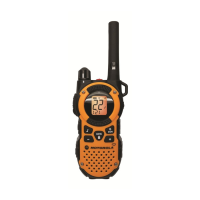


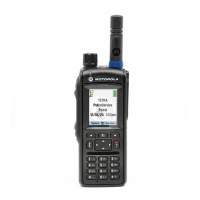
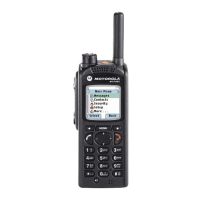
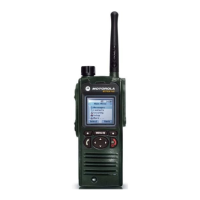


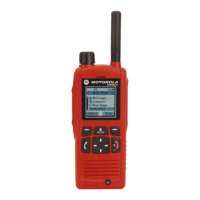
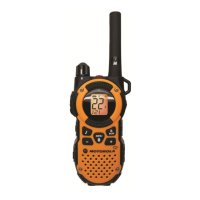
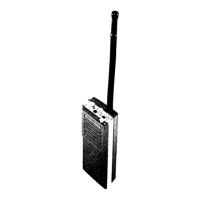

